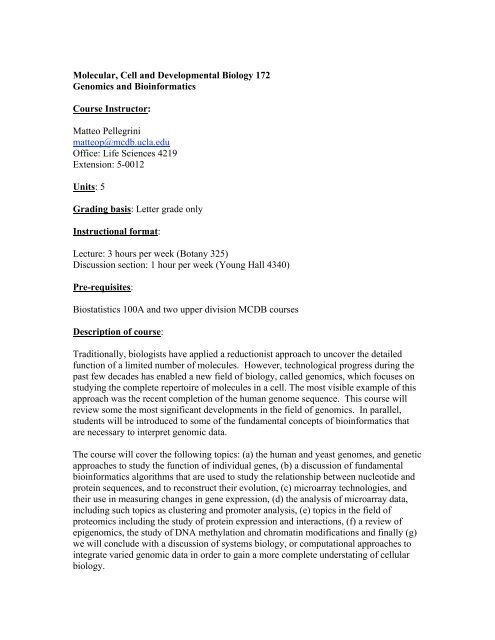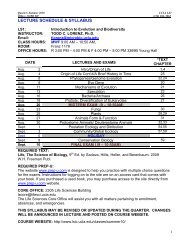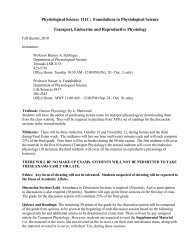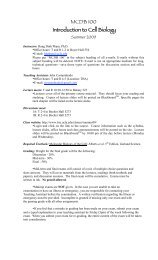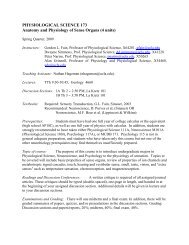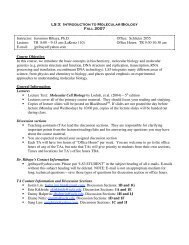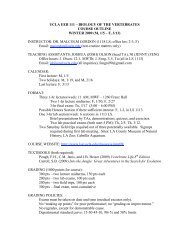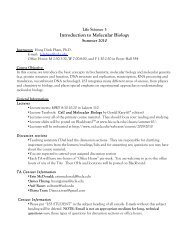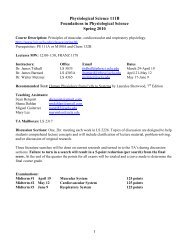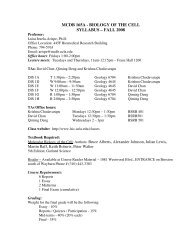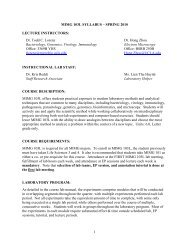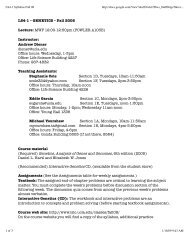Molecular, Cell and Developmental Biology 172 Genomics ... - UCLA
Molecular, Cell and Developmental Biology 172 Genomics ... - UCLA
Molecular, Cell and Developmental Biology 172 Genomics ... - UCLA
You also want an ePaper? Increase the reach of your titles
YUMPU automatically turns print PDFs into web optimized ePapers that Google loves.
<strong>Molecular</strong>, <strong>Cell</strong> <strong>and</strong> <strong>Developmental</strong> <strong>Biology</strong> <strong>172</strong><strong>Genomics</strong> <strong>and</strong> BioinformaticsCourse Instructor:Matteo Pellegrinimatteop@mcdb.ucla.eduOffice: Life Sciences 4219Extension: 5-0012Units: 5Grading basis: Letter grade onlyInstructional format:Lecture: 3 hours per week (Botany 325)Discussion section: 1 hour per week (Young Hall 4340)Pre-requisites:Biostatistics 100A <strong>and</strong> two upper division MCDB coursesDescription of course:Traditionally, biologists have applied a reductionist approach to uncover the detailedfunction of a limited number of molecules. However, technological progress during thepast few decades has enabled a new field of biology, called genomics, which focuses onstudying the complete repertoire of molecules in a cell. The most visible example of thisapproach was the recent completion of the human genome sequence. This course willreview some the most significant developments in the field of genomics. In parallel,students will be introduced to some of the fundamental concepts of bioinformatics thatare necessary to interpret genomic data.The course will cover the following topics: (a) the human <strong>and</strong> yeast genomes, <strong>and</strong> geneticapproaches to study the function of individual genes, (b) a discussion of fundamentalbioinformatics algorithms that are used to study the relationship between nucleotide <strong>and</strong>protein sequences, <strong>and</strong> to reconstruct their evolution, (c) microarray technologies, <strong>and</strong>their use in measuring changes in gene expression, (d) the analysis of microarray data,including such topics as clustering <strong>and</strong> promoter analysis, (e) topics in the field ofproteomics including the study of protein expression <strong>and</strong> interactions, (f) a review ofepigenomics, the study of DNA methylation <strong>and</strong> chromatin modifications <strong>and</strong> finally (g)we will conclude with a discussion of systems biology, or computational approaches tointegrate varied genomic data in order to gain a more complete understating of cellularbiology.
The course material will rely heavily on scientific publications rather than a textbook. Asa result, students will also develop the ability to read <strong>and</strong> underst<strong>and</strong> scientific reportspublished in the top journals.Web site:http://www.lsic.ucla.edu/classes/fall08/Course requirements:1 Presentation2 Midterms1 Final Exam (cumulative)Textbook:None. Reading material <strong>and</strong> copies of research papers will be posted on the course website.Grading:Presentation – 10%Midterms – 40% (20% each)Final – 30%Lab assignments – 20%Effective Date:Fall 2008
LECTURE SCHEDULE FOR MCDB XXXWeek 01 Sep 26, Course overviewWeek 12 Sep 29, The human genome3 Oct 1, Yeast <strong>and</strong> bacterial genomes4 Oct 3, Student presentation5 LAB: UCSC genome Browser: 20 minute introductionexercises (find state of location)Week 26 Oct 6, Sequence alignments: Needleman-Wunsch7 Oct 8, Sequence Alignments: Substitution matrices <strong>and</strong>BLAST8 Oct 10, Student presentation9 LAB:BLASTWeek 310 Oct 13, Genome analysis: Phylogentic profiles, operons<strong>and</strong> genes fusions11 Oct 15, Student presentations12 Oct 17, MIDTERM13 LAB: prepare for midtermWeek 414 Oct 20, Genetic screens in yeast15 Oct 22, RNA interference16 Oct 24, Student presentations17 LAB: Chlamydomonas transcription analysis - SteveWeek 518 Oct 27, Expression Microarrays <strong>and</strong> RNA-seq19 Oct 29, Analysis of microarray data: clustering (kmeans<strong>and</strong> hierarchcal)20 Oct 31, Student presentations21 LAB: Chlamydomonas transcription analysisWeek 622 Nov 3, Proteomics: techniques (MS, 2-hybrid)expression, localization, interactions23 Nov 5, Proteomics: signal transduction24 Nov 7, Student presentation25 LAB: Chlamydomonas transcription analysis
Week 726 Nov 10, Transcriptional regulation: cis motifs27 Nov 12, Transcriptional regulation: regulatory networks28 Nov 14, MIDTERM29 LAB: Prepare for midtermWeek 830 Nov 17, Transcriptional regulation: gene set analysis31 Nov 19, Epigenomics: DNA methylation32 Nov 21, Student presentations33 LAB: Chlamydomonas transcription analysis34Week 935 Nov 24, Epigenomics: the histone code36 Nov 26, Epigenomics: nucleosome positioning37 Nov 28, Thanksgiving holiday38 LAB: Chlamydomonas transcription analysispresentationsWeek 1039 Dec 1, Systems biology: yeast metabolic cycle40 Dec 3, Systems biology: network motifs41 Dec 5, Student presentations42 LAB: Chlamydomonas transcription analysispresentationsWeek 1122 FinalsCourse Reading List:Textebook: noneAdditional reading:Week 0L<strong>and</strong>er, E. S. et al. Initial sequencing <strong>and</strong> analysis of the human genome. Nature 409,860-921 (2001).Week 1Goffeau, A. et al. Life with 6000 genes. Science 274, 546, 563-7 (1996).
Blattner, F. R. et al. The complete genome sequence of Escherichia coli K-12. Science277, 1453-74 (1997).Week 2Needleman, S. B. & Wunsch, C. D. A general method applicable to the search forsimilarities in the amino acid sequence of two proteins. J Mol Biol 48, 443-53 (1970).Altschul, S. F., Gish, W., Miller, W., Myers, E. W. & Lipman, D. J. Basic localalignment search tool. J Mol Biol 215, 403-10 (1990).Dayhoff, M.O., Schwartz, R.M. & Orcutt, B.C. A model of evolutionary change inproteins. Atlas of protein sequence <strong>and</strong> structure 1978.Sneath, P. H. & Sokal, R. R. Numerical taxonomy. Nature 193, 855-60 (1962).Week 3Pellegrini, M., Marcotte, E. M., Thompson, M. J., Eisenberg, D. & Yeates, T. O.Assigning protein functions by comparative genome analysis: protein phylogeneticprofiles. Proc Natl Acad Sci U S A 96, 4285-8 (1999)Bowers, P. M. et al. Prolinks: a database of protein functional linkages derived fromcoevolution. Genome Biol 5, R35 (2004).Lee, I., Date, S. V., Adai, A. T. & Marcotte, E. M. A probabilistic functional network ofyeast genes. Science 306, 1555-8 (2004).Week 4Giaever, G. et al. Functional profiling of the Saccharomyces cerevisiae genome. Nature418, 387-91 (2002).Giaever, G. et al. Chemogenomic profiling: identifying the functional interactions ofsmall molecules in yeast. Proc Natl Acad Sci U S A 101, 793-8 (2004).Kamath, R. S. et al. Systematic functional analysis of the Caenorhabditis elegans genomeusing RNAi. Nature 421, 231-7 (2003).Tong, A. H. et al. Global mapping of the yeast genetic interaction network. Science 303,808-13 (2004).Week 5
Hughes, T. R. et al. Functional discovery via a compendium of expression profiles. <strong>Cell</strong>102, 109-26 (2000).Yamada, K. et al. Empirical analysis of transcriptional activity in the Arabidopsisgenome. Science 302, 842-6 (2003).Eisen, M. B., Spellman, P. T., Brown, P. O. & Botstein, D. Cluster analysis <strong>and</strong> displayof genome-wide expression patterns. Proc Natl Acad Sci U S A 95, 14863-8 (1998).Segal, E., Friedman, N., Koller, D. & Regev, A. A module map showing conditionalactivity of expression modules in cancer. Nat Genet 36, 1090-8 (2004).Mootha, V. K. et al. PGC-1alpha-responsive genes involved in oxidative phosphorylationare coordinately downregulated in human diabetes. Nat Genet 34, 267-73 (2003).David L, Huber W, Granovskaia M, Toedling J, Palm CJ, Bofkin L, Jones T, DavisRW, Steinmetz LM. A high-resolution map of transcription in the yeast genome.Proc Natl Acad Sci U S A. 2006 Apr 4;103(14):5320-5.Week 6Ghaemmaghami, S. et al. Global analysis of protein expression in yeast. Nature 425, 737-41 (2003).Huh, W. K. et al. Global analysis of protein localization in budding yeast. Nature 425,686-91 (2003).Gavin, A. C. et al. Proteome survey reveals modularity of the yeast cell machinery.Nature 440, 631-6 (2006).Wang, R., Prince, J. T. & Marcotte, E. M. Mass spectrometry of the M. smegmatisproteome: protein expression levels correlate with function, operons, <strong>and</strong> codon bias.Genome Res 15, 1118-26 (2005).Linding R, Jensen LJ, Ostheimer GJ, van Vugt MA, Jorgensen C, Miron IM, DiellaF, Colwill K, Taylor L, Elder K, Metalnikov P, Nguyen V, Pasculescu A, Jin J,Park JG, Samson LD, Woodgett JR, Russell RB, Bork P, Yaffe MB, Pawson T.Systematic discovery of in vivo phosphorylation networks. <strong>Cell</strong>. 2007 Jun29;129(7):1415-26.Week 7Harbison, C. T. et al. Transcriptional regulatory code of a eukaryotic genome. Nature431, 99-104 (2004).
Week 8Tavazoie, S., Hughes, J. D., Campbell, M. J., Cho, R. J. & Church, G. M. Systematicdetermination of genetic network architecture. Nat Genet 22, 281-5 (1999).Zhang, X. et al. Genome-wide high-resolution mapping <strong>and</strong> functional analysis of DNAmethylation in arabidopsis. <strong>Cell</strong> 126, 1189-201 (2006).Week 9Kurdistani, S. K., Tavazoie, S. & Grunstein, M. Mapping global histone acetylationpatterns to gene expression. <strong>Cell</strong> 117, 721-33 (2004).Segal, E. et al. A genomic code for nucleosome positioning. Nature 442, 772-8 (2006).Bonneau, R. et al. The Inferelator: an algorithm for learning parsimonious regulatorynetworks from systems-biology data sets de novo. Genome Biol 7, R36 (2006).Week 10Ideker, T. et al. Integrated genomic <strong>and</strong> proteomic analyses of a systematically perturbedmetabolic network. Science 292, 929-34 (2001).Workman, C. T. et al. A systems approach to mapping DNA damage response pathways.Science 312, 1054-9 (2006)van 't Veer, L. J. et al. Gene expression profiling predicts clinical outcome of breastcancer. Nature 415, 530-6 (2002).Seligson, D. B. et al. Global histone modification patterns predict risk of prostate cancerrecurrence. Nature 435, 1262-6 (2005).


